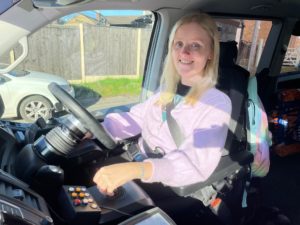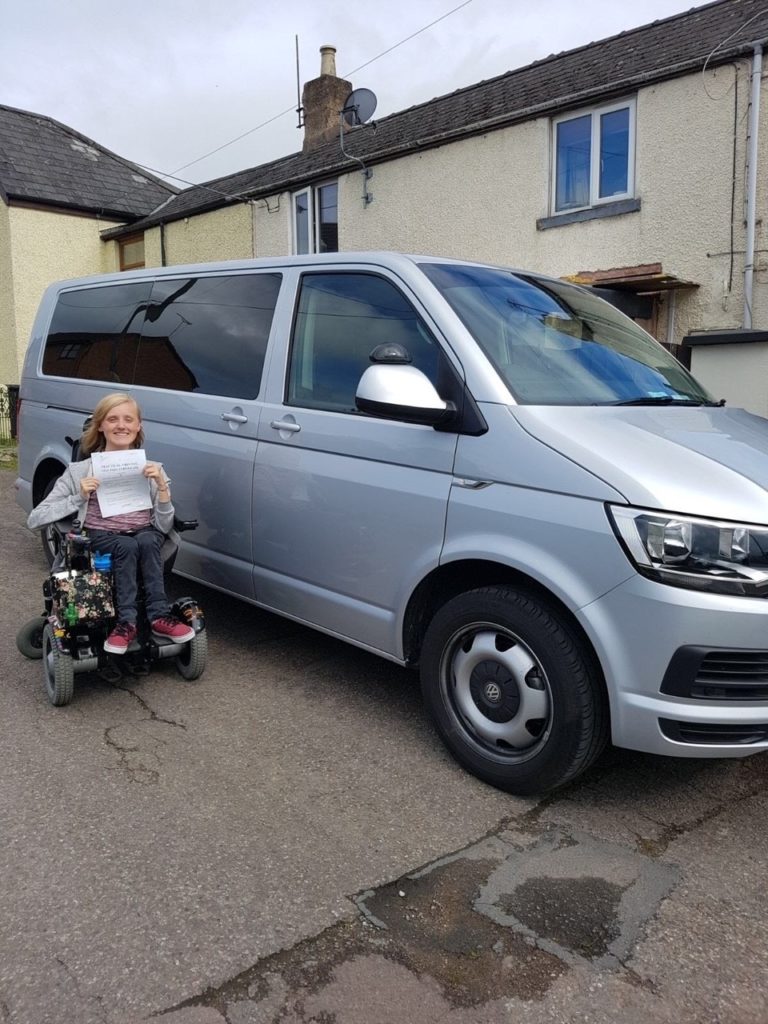Learning to Drive
Learning to Drive
Last updated: May 2024
How long it will take, what will be involved and how complicated it will be for you to get to drive your own car will depend on several things. This includes, for example, your mobility – whether you are a wheelchair user – and your hand and arm strength. If something seems like a barrier, it is still worth exploring. There are so many different adaptations and gadgets available now. If needed, you can drive without touching the pedals or steering wheel. So do not be deterred!
"Talking to others with SMA who drove adapted vehicles also gave me the confidence to deal with negativity from those who were ignorant about the vast possibilities of how the car could be tailored to all my needs. But in true SMA attitude, comments like, “surely you wouldn’t be strong enough?” were very quickly shot down in flames!" Suzanne
"Driving has played such a massive part in my life, enabling me to live as independently as possible. It has also played a key role in helping me maintain my employment and most importantly, my social life!" Ross
If you think you would like to learn to drive and to have your own car, talk to your occupational therapist (OT). If you do not have one, ask your GP for a referral to an OT who can advise you about driving. An OT can also refer you to your local Regional Driving Assessment Centre (RDAC). Talk with your OT about:
- the assessments possible at your nearest centre – you may need to go to a bigger one
- any charges that may apply
- whether there is any support with funding.

It is worth starting the ball rolling before you get to the age when you can apply for a provisional driving licence. That way you know exactly what you will have to do to reach your goal.
We suggest you read through all the key stages and things you need to know in the tabs below. You can then work out which ones will be important for you
You can apply for a provisional driving licence when you are 15 years and 9 months old.
You can start driving a car when you are 17 – but if you get, or have applied for, the enhanced rate of the mobility component of Personal Independence Payment (PIP) or still getting the higher rate of the mobility component of Disability Living Allowance (DLA), you can start to drive a car when you’re 16.
Apply for your first provisional driving licence online – you will need a debit or credit card, proof of your identity (such as a passport or birth certificate), and further evidence showing your National Insurance number and your address details for the last three years. You will need to say you have SMA. The DVLA (Driver and Vehicle Licensing Agency) will contact your health professionals for further information.
If you are a wheelchair user, the vehicle will need to be adapted. So, if your wheelchair needs updating it is best to do this before you get your car. Occupational Therapists (OTs) can advise whether:
adapted. So, if your wheelchair needs updating it is best to do this before you get your car. Occupational Therapists (OTs) can advise whether:
- you would be able to drive a car while you are still sitting in your wheelchair
- you will need to get any adaptations done to your chair
- your wheelchair will soon need changing.
Mobility Centres – practical and independent advice to disabled drivers at Centres across the UK. They will assess your ability to drive as well as provide advice about suitable vehicles, and any adaptations that you may need.
Motability may offer assessments providing you get the enhanced rate of the mobility component of Personal Independence Payment (PIP), or the higher rate of the mobility component of Disability Living Allowance (DLA). See below for more information.
RDAC (Regional Driving Assessment Centre) – centres throughout England for driving assessments and advice on vehicle adaptations and high technology solutions. Some centres provide assessments on site; others might be able to arrange a home visit, bringing a vehicle containing different equipment for you to try. The two main centres with the biggest set up are in Solihull and Manchester.
Driving Assessments & Vehicle Adaptations
Disability Driving Instructors – Phone 0844 800 7355 – advice on how to start learning to drive and finding a driving instructor.
Disability Action in Northern Ireland – assessments, information on learning to drive and help to set up appointments with Motability.
This enables disabled people to lease a new car, scooter or powered wheelchair, using their mobility allowance. You may be eligible to join the Motability Scheme if you receive the:
- Enhanced Rate of the Mobility Component of Personal Independence Payment (PIP) or
- Higher Rate Mobility Component of Disability Living Allowance (DLA)
The Scheme includes:
- Lease of a new car, scooter or powered wheelchair every three years; five years for a wheelchair accessible vehicle (WAV)
- Insurance from Royal and Sun Alliance Insurance plc (RSA)
- Breakdown assistance
- Servicing, maintenance and repairs
- Adaptations, many at no extra cost
Deposits and down payments apply depending on your circumstances so it’s important that you read the information on their website carefully or phone them to talk about what might be possible for you.
When you apply – using their application form (you will need to explain why it’s so important that you drive) – to be able to travel independently should be enough reason but add any other reasons about lack of accessible transport where you live, travelling to college / work etc.
So, if you’re eligible and you do decide to use Motability, the next steps are:
- Choosing a vehicle – there’s a lot to think about, including the cost of the vehicle, if it will be the right one for you and its fuel consumption as you will definitely have to cover this cost. Motability can provide information to help you with this.
- Searching for dealers – nearly 5,000 dealerships across the UK offer Motability. You would be able to talk to a Motability specialist at any of them and test drives can be arranged
- Ordering a vehicle – which can be done online.
Motability provide a vehicle for up to 5 years, so you would need to try and think ahead about what you may need to be able to drive the same vehicle for that length of time. Your OT is the best person to advise you. Motability also need to make sure that you would be happy and confident with the controls before they are installed.
Motability – Phone 0300 456 4566
Local authorities administer the Blue Badge system which entitles people with severe mobility problems to parking concessions. These may apply to on street parking and might include free use of parking meters and pay-and-display bays. Some areas might also offer exemption from toll charges.
Driving Theory Test – anyone must take and pass a driving theory test before booking their practical test. There is a cost and the test has to be taken at a driving theory test centre. You can take it from your 16th birthday if you get, or have applied for, the enhanced rate of the mobility component of the Personal Independence Payment (PIP).
Preparing for the Theory Test – there are two parts: a multiple-choice section and hazard perception
Book Your Theory Test – this online form will take you through questions about any access needs or other needs you have that will need to be met by the test centre for you to take the theory test.
Once you’ve passed the theory test (and it’s not uncommon to have to try more than once or twice), you have two years to pass the practical test. If you let it go longer than this, you have to take it again.
It can be helpful to learn and take the test in your own car, and for some of you who are going to need very individual adaptations, this may be essential. It’s probably worth finding someone to teach you who has taught other disabled people.
Gov.UK / finding a driving instructor and lessons
Disability Driving Instructors – Phone 0844 800 7355 – advice on how to start learning to drive and finding a driving instructor.
Motability – if you’re eligible they might help pay for some of your driving lessons. Phone 0300 456 4566 or go to: Motability – Driving Lessons
Gov.UK / Driving Test – Cars – gives an overview.
When you book your test, you will need to advise the Test Centre of your disability. Your driving instructor will help you.
Congratulations!
Pass Plus – a 6-hour training course you could take to further improve your skills.
Disabled Motoring UK is a charity working with government and businesses across the UK to improve parking, refuelling, and access provision for disabled people.
Jordanne with her test certificate and drive -in van.

- would like a printed copy of this information
- have questions we haven’t answered
- need support
